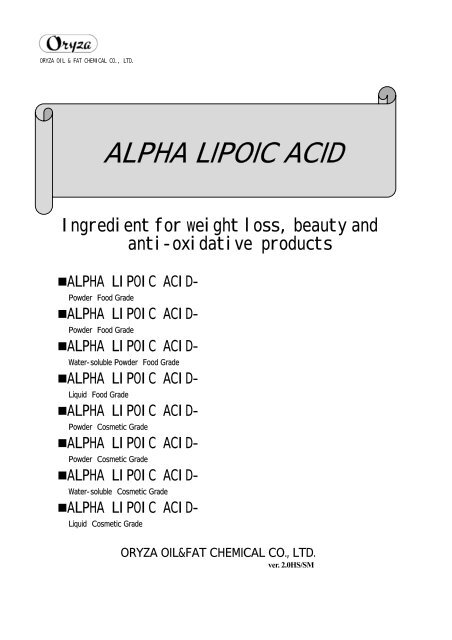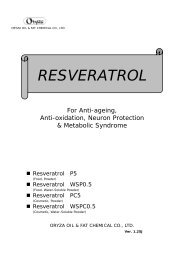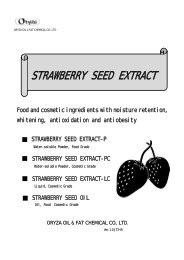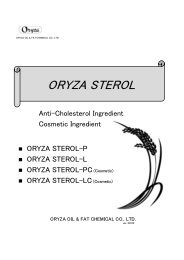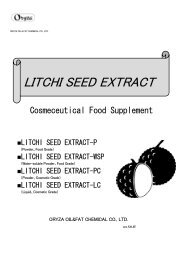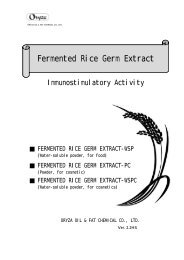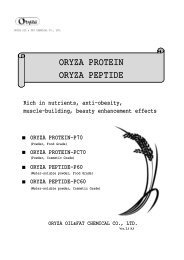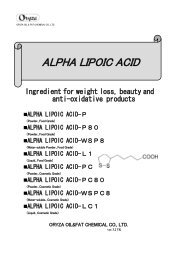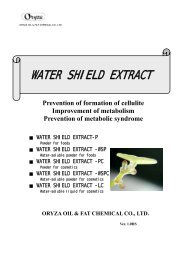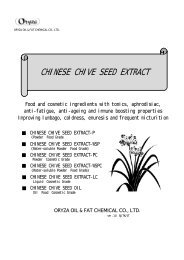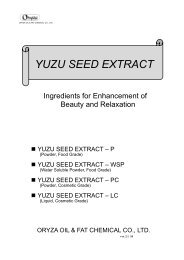ALPHA LIPOIC ACID
ALPHA LIPOIC ACID
ALPHA LIPOIC ACID
You also want an ePaper? Increase the reach of your titles
YUMPU automatically turns print PDFs into web optimized ePapers that Google loves.
••••••••ver. 2.0HS/SM
<strong>ALPHA</strong> <strong>LIPOIC</strong> <strong>ACID</strong> ver.2.0 HS/SM<strong>ALPHA</strong> <strong>LIPOIC</strong> <strong>ACID</strong>Ingredient for weight loss, cosmetics andanti-oxidative preparations1. Introductionα-Lipoic acid (thioctic acid) is a potent anti-oxidant that has been widely used in food supplementpreparations. α-Lipoic acid has been used to alleviate peripheral pain in severe diabetic patients and itsapplication in food preparations is getting popular. According to “Standards Concerning the Scope ofPharmaceutical Products” by PFSB Notification No. 0331009 dated March 31, 2004, the Ministry of Health,Labor & Welfare has revised and re-categorized α-lipoic acid as an “additive to be used in general foodpreparations or beverages”.SCOOHSHS SH Fig. 1. α-lipoic acidCOOH α-Lipoic acid (Fig. 1) is usually present in the mitochondrial matrix in the cells of organisms where cellsmetabolisms and energy production take place. Adenosine triphosphate (ATP), the energy required forcellular activities, is produced from metabolism of glucose via series of pathways, namely glycolysis, citric acidcycle, electron transfer and oxidative phosphorylation as shown in Fig. 2. Pyruvic acid produced fromglycolysis is converted to acetyl CoA, a substrate for ATP production by pyruvate dehydrogenase, the enzymethat catalyzes the conversion. α-Lipoic acid has been found to enhance the action of pyruvate dehydrogenase.α-Lipoic acid normally exists in the reduced form in living organisms, and catalyzes oxidative decarboxylationprocess converting pyruvate to acetyl CoA. Hence, α-lipoic acid is essential for energy production in cells.At Oryza Oil & Fat Chemical Co., Ltd., innovative process has been developed for theproduction and commercialization of α-lipoic acid enabling its application in the food industry.In addition, liquid form α-lipoic acid with high water dispersibility has been developed for itsincreasing demand in the beverages industry. Meanwhile, studies have been carried out inOryza Oil & Fat Chemical Co., Ltd. to evaluate the various beneficial effects of α-lipoic acid,e.g. skin whitening effect, inhibition of adipocytes production and growth promoting effect on1
<strong>ALPHA</strong> <strong>LIPOIC</strong> <strong>ACID</strong> ver.2.0 HS/SMmuscle cells.Glucose[Energy source]Glycolysis systemA system for extracting the energy reserved inglucose molecule at the maximum efficiencyPyruvic acid[An intermediate of fuel molecule ]CO 2[Activation]Pyruvate dehydrogenase[Metabolization ]-lipoic acidAcetyl CoA[A starter of energy production, a fuel molecule ]Citric acid cycleA circuit for oxidizing fuel molecules ,decomposing them into water and carbon dioxideCO 2 e -H 2 O[Electron]Electron transfer systemA pathway for producing ATPH 2 OATP*EnergyConstriction of the muscle;used as kinetic energy* Adenosine triphosphateFig. 2. Energy Production from Glucose and Site of Action of α-Lipoic Acid2
<strong>ALPHA</strong> <strong>LIPOIC</strong> <strong>ACID</strong> ver.2.0 HS/SM2. Promotion of Weight LossBreakdown of Fats and Promote the Maintenance of Lean MuscleStudy suggested that α-lipoic acid enhances glucose utilization by increasing insulinsensitivity in advanced diabetic patients. 1 Meanwhile, Burke et. al. 2 found that co-ingestion ofα-lipoic acid with creatine and small amount of sucrose enhances muscle total creatine content.Creatine is important for the production of energy and lipid catabolism in muscles. As skeletalmuscle tissue is the major site for glucose following a meal, α-lipoic acid that enhances glucoseuptake by skeletal muscle is potentially useful in weight reduction and long term preventionagainst obesity.1) Saengsirisuwan V., Perez F. R., Sloniger J. A., Maier T., Henriksen E. J. Interaction of exercise trainingand -lipoic acid on insulin signaling in skeletal muscle of obese Zucker rats. Am. J. Physiol.Endocrinol. Metab. 287E529-536 (2004).2) Burke D. G., Chilibeck P. D., Parise G., Tarnopolsky M. A., Candow D. G. Effect of -lipoic acidcombined with creatine monohydrate on human skeletal muscle creatine and phosphagen concentration.Int. J. Spot. Nutr. Exerc. Metab. 13, 294-302 (2003).(1) Promotion of Muscle Cell Growth (in Vitro)The effect of α-lipoic acid on muscle cell lines, L6 cells, was examined. L6 cells werecultured with α-lipoic acid for 24 hours. Fig. 3 shown that cell production increases in thepresence of α-lipoic acid. α-lipoic acid promote muscle growth and maintenance of healthy leanmuscle. Fig. 3. Effects of α-Lipoic Acid on L6 Muscle Cells (Mean ± S.E., n=6)3
<strong>ALPHA</strong> <strong>LIPOIC</strong> <strong>ACID</strong> ver.2.0 HS/SMMethodL6 cells (5x10 4 cells/ml) were suspended and cultured in D-MEM medium containing 10%bovine fetal serum, 100 units/ml of penicillin G and 100µg/ml of streptomycin. 100µl of theabove suspension was distributed into 96-well microplate. Different concentrations of α-lipoicacid was added and the mixture was incubated for 24 hours. Degree of cell growth wasdetermined by MTT assay.(2) Promotion of Muscle Cell Growth (in Vivo)Further study was prompted to examine the effect of α-lipoic acid in vivo. Mice were fedwith diet containing α-lipoic acid for 24 days. Weight of the posterior limb (soleus muscle)was measured. Muscle weight increases in mice fed with diet containing α-lipoic acid (asillustrated in Fig. 4). α-Lipoic acid is effective in promoting muscle growth. Fig. 4. Effects of Continuous Intake of α-Lipoic Acid on the Weight of the Soleus Muscle in Mice (mean ±S.E., n=6)MethodMice (ddy strain, male, 5 weeks old) were fed with diet (MF: Oriental Yeast Co., Ltd)containing α-lipoic acid (concentration 0.05% & 0.1%) for 24 days. Weight of soleus musclewas measured.In another study conducted by Dicter N et. al. 3 , α-lipoic acid shown to cause mitochondrialuncoupling and inhibition of glycogen synthesis. Glucose metabolism is regulated and weightmaintenance is achieved.3) Dicter N., Madar Z., Tirosh O. -lipoic acid inhibits glycogen synthesis in rat soleus muscle via itsoxidative activity and the uncoupling of mitochondria. J. Nutr. 132, 3001-3006 (2002).4
<strong>ALPHA</strong> <strong>LIPOIC</strong> <strong>ACID</strong> ver.2.0 HS/SM(3) Inhibition of Adipocytes Differentiation (in Vitro)α-Lipoic acid has been shown to inhibit the differentiation of 3T3-L1 pre-adipocytes inducedby a hormonal mixture or troglitazone 4 . Similar study was conducted at Oryza Oil & FatChemical Co., Ltd., the size of cell and internal oil vesicles were significantly reduced byα-lipoic acid (as illustrated in Fig. 5)4) Cho K. J., Moon H. E., Moini H., Packer L., Yoon D. Y., Chung A. S. -lipoic acid inhibits adipocytedifferentiation by regulating pro-adipogenic transcription factors via mitogen-activated protein kinasepathway. J. Biol. Chem., 278, 34823-34833 (2003). Control1g/mL3g/mL10g/mLFig. 5. Effects of α-Lipoic Acid on Adipocyte DifferentiationMethod3T3-L1 adipocytes (5x10 4 cells/ml) were incubated in D-MEM medium (high glucose)containing 10% bovine fetal serum for 2 days. The medium was then replaced by anothermedium containing insulin (1µg/ml), dexamethasone (0.25µM), isobutylmethylxanthine (0.5mM) and different concentrations of α-lipoic acid. The new medium was further incubated for atotal of 7 days. α-lipoic acid and insulin (1 µg/ml) was replaced every 2 days.In adipocytes, an enzyme exists that converts glucose that is taken by insulin to triglyceride.The enzyme, glycerol 3-phosphate dehydrogenase (GPDH), is involved in this process to store5
<strong>ALPHA</strong> <strong>LIPOIC</strong> <strong>ACID</strong> ver.2.0 HS/SMexcessive glucose-derived energy in fat cells. We studied the activity of-lipoic acid on crudeGPDH prepared from 3T3-L1 adipocytes and discovered that it has inhibitory activity (Fig. 6).Namely, --lipoic acid prevents fat accumulation converted from excessive sugar.GPDH Activity(Unit/mL) Concentration(g/L)Fig. 6 Effect of -Lipoic Acid on Fat Cell-derived GPDH activity (n=2-3)MethodThe lysate prepared from differentiated 3T3-L1 cells was used as the enzyme source. GPDHactivity was measured by commercioally available kit (Primary Cell), Japan.(4)Preventive effect on body weight gain in miceWe examined how-lipoic acid influences weight gain in which were fed diet mice freely for13 days with mild exercise. As shown in Fig. 7, the effect to prevent weight gain was weak byoral administration of-lipoic acid (0.1%) only. However, -lipoic acid supplementation withmild exercise significantly boosted its effect to prevent weight gain.Change in mice Weight (g) Control-lipoic acid 0.1%Only exercising-lipoic acid 0.1% with exercising DayFig. 7 Change in Mice Weight Fed -Lipoic Acid Continuously with or without Exercise (n=5)6
<strong>ALPHA</strong> <strong>LIPOIC</strong> <strong>ACID</strong> ver.2.0 HS/SMMethodMice (ddY, male, 5 weeks old) were fed the diet (MF, Oriental Yeast) that includes -lipoic acid (0.1%) for13 days. Exercise was loaded with a treadmill (MK-770M, Muromachi Kikai) for ten minutes (5 rpm/min)once a day.(5) Continuous ingestion test in healthy menIn order to evaluate the effect of -lipoic acid on bady weight in human, we conducted aningestion test on our healthy male employees. Eight of them were taken 100 mg of -lipoicacid and 10 employees took 200 mg for 4 weeks. After ingestion their obesity indexes and bloodparameters were compared before and after the test.In the group that took 100 mg of -lipoic acid a day, their body fat ratio, impedance, fat amount,and hip sizes were reduced. There was a change in their serum parameters as well. Their bloodsugar level was significantly lowered (p
<strong>ALPHA</strong> <strong>LIPOIC</strong> <strong>ACID</strong> ver.2.0 HS/SMTable 2: Obesity Indexes and Blood Parameters before and after Taking - Lipoic Acid (200 mg)Parameters Before Taking After Taking The Number of TheImprovement/All ExampleWightkg Body Fat% BMIkg/m 2 ImpedanceΩ Fat Content% Degree of Obese (%) Waist Sizecm Hip Sizecm Waist / Hips Thickness of Abdominal Fatmm Blood Sugarmg/dL Cholesterolmg/dL HDL- Cholesterolmg/dL Triglyceridemg/dL Phosphatidemg/dL Creatininemg/dL Total Proteing/dL Value are shown with the average of 10 subjects with standard deviation.Wight Impedance Body Fat Fat ContentBMI Before After Before After Before After Before After Before After8
<strong>ALPHA</strong> <strong>LIPOIC</strong> <strong>ACID</strong> ver.2.0 HS/SMDegree of ObeseWaist SizeHip SizeWaist / HipThickness of Abdominal Fat Before After Before After Before After Before After Before AfterBlood Sugar CholesterolHDL-CholesterolTriglyceridePhosphatideBefore After Before After Before After Before After Before After CreatinineTotal Protein Before After Before AfterFig. 8 Changes in Obesity Indexes and Blood parameters before and after Taking α-Lipoic Acid (100 mg)9
<strong>ALPHA</strong> <strong>LIPOIC</strong> <strong>ACID</strong> ver.2.0 HS/SM3. Cosmeceutical Effects(1) Skin-Whitening EffectEffect on melanin formation (in vitro)The effect of α-lipoic acid on B16 melanoma cells was examined. As illustrated in Fig. 9,α-lipoic acid demonstrated a dose-dependent suppression effect on melanin formation. α-lipoicacid is a potentially useful skin whitening agent. Fig. 9. Effects of α-Lipoic Acid on Melanocyte (B16) Growth (mean ± S.E., n=6)MethodB16 melanoma cells (5x10 4 cells/ml) were suspended in MEM medium (containing 10% fetal bovine serum,100 units/ml penicillin and 100µg/ml streptomycin) containing 2mM theophylline, and 500µl of the suspensionwas placed into a 24-well plate. Different concentration of α-lipoic acid (55µl) was added and the mixtureswere incubated for 3 days. After incubation, PBS (300 µl) was added and cells were crushed by ultrasonication.Crushed cell mixture was recovered on a 96-well plate and absorbance was determined atwavelength 415 nm (reference wavelength 700 nm).Activity to reduce pigmentation (in vivo)We examined the effect of α-lipoic acid given continuously to brown guinea pigs according tofollowing protocol. Then we studied how it reduces pigmentation caused by UV rays. As shownin Fig. 10, the color value on the radiation area of the control group (0 mg/kg of α-lipoic acid)on the 8th and 10th day after the start of UV exposure clearly lowered as compared to beforeexposure (day 0). In the group that took α-lipoic acid (25 and 50 mg/kg), the color value on theradiation area increased (Refer to the photo in Fig. 11.) This indicates that α-lipoic acid controls10
<strong>ALPHA</strong> <strong>LIPOIC</strong> <strong>ACID</strong> ver.2.0 HS/SMpigmentation, proving that it performs skin-lightening activity with oral intake both in vitro andin vivo.Start of AdministrationMeasurement of the color valueUV ray exposureUV ray exposureUV ray exposureUV ray exposureMeasurement of the color valueUV ray exposureEnd of Administration-2 0 2 4 6 8 10 120Change L in the color value(L Dark Light-2-4-6-8-10-12-14Day after first UV ray exposure(Day)0 mg/kg1 mg/kg25 mg/kg50 mg/kgFig. 10 Effect of α-Lipoic Acid on Pigmentation Formation caused by UV rays in BrownGuinea Pigs (average value +/- SD, n=3)MethodBrown guinea pigs (male, 4 weeks old)were given α-lipoic acid daily from 2 days before (day -2) UV rayradiation (day 0). UV rays (UV-B, 2,000 mJ/cm 2 ) ware radiated to the hair-shaved back of the guinea pigs usinga UV-ray radiator (Solar Simulator manufactured by Ushio, Inc, Japan.) 4 times from day 0 to day 3. α-lipoicacid was given orally from day -2 to day 10 including the period of UV ray radiation. The color value (L*value) of the radiation area was measured using a spectro-color-difference meter (Nippon DenshokuIndustries Co., Ltd.) before UV ray radiation (day 0) and 8th and 10th days after starting the radiation.11
<strong>ALPHA</strong> <strong>LIPOIC</strong> <strong>ACID</strong> ver.2.0 HS/SM Fig. 11 Radiation Area on the 8th Day after Starting the Radiation12
<strong>ALPHA</strong> <strong>LIPOIC</strong> <strong>ACID</strong> ver.2.0 HS/SM(2) Skin-rejuvenating Effect Effect of α-Lipoic Acid on Neonatal Dermal Fibroblasts (In Vitro)The effect of α-lipoic acid on neonatal dermal fibroblasts was examined using NB1RGBcells. Fig. 12 illustrates the effect of α-lipoic acid on fibroblasts cells proliferation. It is evidentthat α-lipoic acid stimulate growth of human fibroblasts thus promote skin suppleness andrejuvenate aging skin.1201101009080Control 1 5 25µFig. 12. Effects of α-Lipoic Acid on NB1RGB Fibroblast Growth (mean ± S.E., n=6)MethodNB1RGB cells (2x10 5 cells/ml) were suspended in α-MEM medium (containing 10% bovine fetal serum,100 units/ml penicillin and 100µg/ml streptomycin), and 100µl of the suspension was placed into a 96-wellplate. Different concentration of α-lipoic acid (10 µl) was added and incubated for 2 days. Degree of cellgrowth was determined using MTT assay. Effect of α-Lipoic Acid on Skin Turnover Rate (In Vitro)The effect of α-lipoic acid on skin turnover rate was examined using three-dimensionalreconstructed skin cell model. As illustrated in Fig. 13, model treated with α-lipoic acid has amore uniformed distribution of skin cells. The granule containing cells are aligned in a flatmonolayer. In contrast, the granule containing cell was hardly visible in controlled model.This suggested that α-lipoic acid promotes healthy skin turnover and promote skin suppleness.13
<strong>ALPHA</strong> <strong>LIPOIC</strong> <strong>ACID</strong> ver.2.0 HS/SMControlCorneumDispersed regionof granule cellsEpidermisDermis-lipoic acid(1 g/mL)GranulesCorneumDispersed region ofgranule cellsEpidermisDermisFig. 13. Three-Dimensional Images of Artificially Reconstructed Skin Cell ModelMethodReconstructed human skin model (TESTSKIN TM : Toyobo Co., Ltd) was used. α-lipoic acid was injectedinto the dermal layer of skin and incubated for 6 days. The medium was replaced every 3 days. Cross section oftissue specimens were prepared after treatment in 10% formalin. Changes in specimens was observed undermicroscopic enlargement.14
<strong>ALPHA</strong> <strong>LIPOIC</strong> <strong>ACID</strong> ver.2.0 HS/SM4. Antioxidative EffectsThe antioxidative effect of α-lipoic acid has been renown for years. Studies were carried outto confirm its anti-oxidative effect. As illustrated in Fig. 14 and Fig. 15, α-lipoic acid showed adose-dependent antioxidative effect. α-lipoic acid is a potentially useful antioxidant for theprevention of degenerative diseases. Fig. 14. SOD-Like Activities of α-Lipoic Acid Fig.15. DPPH Radical-Scavenging Activities of α-Lipoic Acid5. Water Soluble α-Lipoic AcidWe successfully developed solubilized α-lipoic acid powder with high water solubility (AlphaLipoic Acid-WSP8, WSPC8). This powder can be used for enables in beverages (refreshmentsand soft drinks and liquid cosmetics). As shown in photos (Fig16), WSP8 and WSPC8 can bedissolved in water quicker and kept the clearer as compared to conventional product. Moreover,the taste of α-lipoic acid(tingling sensation) has been reduced.Modified product(WSP8 and WSPC8)conventional productFig. 16 Comparison of Water Solubility of Alpha Lipoic Acid-WSP8 and WSPC815
<strong>ALPHA</strong> <strong>LIPOIC</strong> <strong>ACID</strong> ver.2.0 HS/SM6. Stabilities of <strong>ALPHA</strong> <strong>LIPOIC</strong> <strong>ACID</strong>(1) Thermal StabilityThermal stability of α-lipoic acid was examined. α-lipoic acid easily destroyed at temperatureas low as 60ºC (as illustrated in Fig. 17). In general, there is a 25% loss of α-lipoic acid uponheating at temperature >60ºC. Caution is required when α-lipoic acid is used in foodpreparations due to its sensitivity to heat. Percentage loss during heating is important factor forconsideration when determining the quantity to be used.Fig. 17. Thermal Stability of α-Lipoic Acid(2) pH StabilityThe effect of pH on α-lipoic acid was examined at room temperature in dark for 1 day and 1week. α-lipoic acid is highly remained stable at wide pH range, pH 3-10 (as shown in Fig. 18). Fig. 18. Effect of pH on α-Lipoic Acid16
<strong>ALPHA</strong> <strong>LIPOIC</strong> <strong>ACID</strong> ver.2.0 HS/SM7. Nutritional InformationResultsMethodMoisture 0.2 g/100 g Karl Fischer ReagentProtein *1 0.0 g/100 g Kieldahl methodFat 99.8 g/100 g Direct extraction methodAsh 0.0 g/100 g Direct ashing methodCarbohydrate *20.0 g/100 gEnergy *3898 kcal/100 gDietary fiber 0.0 g/100> Prosky methodSodium 1 mg/100 g Atomic absorption spectrophotometory*1 N=6.25*2 100 – (moisture + protein + fat + ash)*3 Factors for calculating the energy valueprotein, 4; fat, 9; carbohydrate, 4; dietary fiber, 2Tested by:SRL, Inc.Date of issue of the test result reportSeptember 2, 2004Research result issue numberNo. 2004082000168. Safety Profile(1) Acute Toxicity (LD 50 )In the single-dose toxicity test in ddY mice, the LD 50 values of α-lipoic acid were 405 mg/kg and 277mg/kg in male and female mice, respectively. These values correspond to ingestion of 16.6 g and 24.3 g, ofα-lipoic acid, in adult humans weighing 60 kg.(2) Acute Skin Irritation Study in RabbitFollowing the OECD Guideline No. 404 (April 24, 2002 )and Commission Directive 2004/73/EC, acuteskin irritation study was perfomed by using 3 rabbits (New Zealand white). After application of α-lipoic acid(0.5 g) to the normal skin in the state of obstruction for 4 hours, irritation was judged by using the Draizemethod after 1, 24, 48, and 72 hours later and was calculated by using p.i.i. (primary irritation index).As the result of the examination, slight erythematous was observed in 3 rabbits after 1 hour. Althougherythematous was not observed after 24 hours, and recovery was confirmed. The p.i.i. of α- lipoic acid wasconfirmed with 0.0. Hence,α- lipoic acid was not found to be acute irritatable substance for the rabbit skins.Tested by: Safepharm Laboratories LimitedDate of issue of the test result report : August 1, 2005Research result issue number :1600/00717
<strong>ALPHA</strong> <strong>LIPOIC</strong> <strong>ACID</strong> ver.2.0 HS/SM(3) Cumulative Skin Irritation Study in Guinea PigThe 0.1%, 1% and 10% α- lipoic acid solutions(0.05mL) ,diluted with ethanol were applied at once a dayfor 14 days on the skin of 3 guinea pigs. Skin lesions were evaluated every day.Under the experimental conditions adopted, the test substance was found to be non-irritant for the skins ofguinea pig.(4) Acute Eye Irritation Study in rabbitFollowing the OECD Guideline No. 405 (April 24, 2002) and Commission Directive 2004/73/EC,α-lipoic acid (70 mg) was administered into the eyes of 3 rabbits (New Zealand white) and the conditions oftheir eyes were observed without washing out 1, 24, 48, and 72 hours later and on the 7th, 14th, and 21stdays.On the eyes of all of rabbit, cloudiness of cornea, iris inflammation, and medium level stimulation onconjunctiva were observed. The eyes of one rabbit ware recovered to their normal conditions 7 days later and theothers 21 days later.According to the evaluation of the result using the standard determined by Kay, the mean value ofmaximum group was 26.0 that was observed 48 hours later. We confirmed that α-lipoic acid has mediumlevel irritation on rabbit eyes (level 5 among levels 1 through 8).(5) Sensitization TestFollowing the OECD Guideline No. 429 (April 24, 2002 )and Commission Directive 2004/73/EC,sensibilization test (LLNA Assay) was perfomed in 10%, 25%, and 50% concentrations of α-lipoic acid byusing the 4 mice at each group .As a result of the examination, α-lipoic acid was not found to be sensitizing ability at 10,25,and 50%.Tested by: Safepharm Laboratories LimitedDate of issue of the test result report : August 1, 2005Research result issue number : 1600/008(6) Mutagenicitiy Test (Ames test)Following the OECD Guideline No. 471, and Commission Directive 2004/73/EC, Ames test wasperformed. The test was performed using by Samonella typhimurium TA1535, TA1537,TA98 and TA100,and Escherichia coli WP2 urvA. Under the conditions with or without S9mix.The result showed α-lipoic acid possessed no mutagenicitiy at the concentrations of 50 to 5000 µg/plate.Tested by: Safepharm Laboratories LimitedDate of issue of the test result report : August 12, 2005Research result issue number : 1600/01018
<strong>ALPHA</strong> <strong>LIPOIC</strong> <strong>ACID</strong> ver.2.0 HS/SM(7) Residual SolventsAssayed Items Results Detection Limits Assay MethodCyclohexane Not Detected 5 ppm GC-MSEthyl acetate Not Detected 5 ppm GC-MSToluene Not Detected 5 ppm GC-MSAcetone Not Detected 5 ppm GC-MSHexane Not Detected 5 ppm GC-MSDichloromethane Not Detected 1 ppm GC-MSTested by: Japan Food Research Center FoundationDate of issue of the test result reportOctober 1, 2004Research result issue numberNo. 304090482-00119
<strong>ALPHA</strong> <strong>LIPOIC</strong> <strong>ACID</strong> ver.2.0 HS/SM9. -Lipoic Acid Polymers (Impurity)(1) Structure of -lipoic Acid Polymer -lipoic acid sometimes generates polymers (impurity) during heat-drying or purification process usingethanol. We analyzed the structure of -lipoic acid polymer A (polymer generated during heat-drying) and -lipoic acid polymer B (polymer generated in ethanol solution) at Osaka University Graduate School (professor:Nobutoshi Murakami). Fig. 18 shows the clarified structure of-lipoic acid polymers A and B.1R2RSSnPolymer A :Polymer B :1 2 C O O HR = R = H o r1 2 C O O R 3R = R = H o r R3= H o r E tFig. 18. Structure of -lipoic acid Polymers A and B.(2) Safety of -lipoic acid polymer (Acute toxicity) We conducted a single-dose test of -lipoic acid polymer B in dog (beagle, male).-lipoic acid polymerB(500 mg/kg) was given to dog, and overall condition was observed. Moreover hematologic test andbiochemical examination of blood was performed. There was no change in its overall condition and no acutesymptoms occurred in liver or kidney function within 24 hours after administration.20
<strong>ALPHA</strong> <strong>LIPOIC</strong> <strong>ACID</strong> ver.2.0 HS/SM10. Recommended Daily Dose<strong>ALPHA</strong> <strong>LIPOIC</strong> <strong>ACID</strong>: 50~100 mg/day11. Applications of <strong>ALPHA</strong> <strong>LIPOIC</strong> <strong>ACID</strong>Bland Names Applications Examples<strong>ALPHA</strong> <strong>LIPOIC</strong>The product is the powder of -lipoic acid for foods.<strong>ACID</strong>-P, P80Soft gel capsule, hard capsule, tablet, etc.Drinks (beverage, juice, etc.), soft gel capsule,<strong>ALPHA</strong> <strong>LIPOIC</strong> The product is water-soluble powder for foods. It is suitablehard capsule, tablet, candy,<strong>ACID</strong>-WSP80 for beverages.chewing gum, cookies, chocolate, jelly, etc.<strong>ALPHA</strong> <strong>LIPOIC</strong> The product is the liquid of -lipoic acid for foods. It is Soft gel capsule, candy,chewing gum,<strong>ACID</strong>-L1 suitable for dough.cookies, chocolate, jelly, etc.Face care (milk, cream, etc.)<strong>ALPHA</strong> <strong>LIPOIC</strong><strong>ACID</strong>-PC, PC80 The product is the powder of -lipoic acid for cosmetics. Body care (body cream, soap etc.)Makeup (lipstick, foundation, etc.)Face care (lotion, milk, cream, etc.)<strong>ALPHA</strong> <strong>LIPOIC</strong> The product is water-soluble powder for cosmetics. It is Body care (body lotion, body cream, soap<strong>ACID</strong>-WSPC80 suitable for toners and conditioning lotions.etc.)Makeup (lipstick, foundation, etc.)<strong>ALPHA</strong> <strong>LIPOIC</strong> The product is liquid of -lipoic acid for cosmetics. It isMakeup (lipstick, etc.)<strong>ACID</strong>-LC1 suitable for cosmetics.12. Packaging<strong>ALPHA</strong> <strong>LIPOIC</strong> <strong>ACID</strong>-P, P80, WSP8 (Powder, Food Grade)<strong>ALPHA</strong> <strong>LIPOIC</strong> <strong>ACID</strong>-PC, PC80, WSPC8 (Powder, Cosmetic Grade)5kg Interior packaging : aluminum-coated plastic bagExterior packaging : cardboard box<strong>ALPHA</strong> <strong>LIPOIC</strong> <strong>ACID</strong>-L1 (Liquid, Food Grade)<strong>ALPHA</strong> <strong>LIPOIC</strong> <strong>ACID</strong>-LC 1(Liquid, Cosmetic Grade)5kg Interior packaging : cubic polyethylene containerExterior packaging : cardboard box21
<strong>ALPHA</strong> <strong>LIPOIC</strong> <strong>ACID</strong> ver.2.0 HS/SM13. StorageStore in cool, dry place. Avoid humidity. In particular, <strong>ALPHA</strong> <strong>LIPOIC</strong> <strong>ACID</strong>-L1,and <strong>ALPHA</strong> <strong>LIPOIC</strong><strong>ACID</strong>-LC1 is stored under 5.14. Expression of the indication <strong>ALPHA</strong> <strong>LIPOIC</strong> <strong>ACID</strong>Food<strong>ALPHA</strong> <strong>LIPOIC</strong> <strong>ACID</strong>-P, P80, WSP8, L1Example : -Lipoic Acid , Thioctic AcidCosmetic <strong>ALPHA</strong> <strong>LIPOIC</strong> <strong>ACID</strong>-PC <strong>ALPHA</strong> <strong>LIPOIC</strong> <strong>ACID</strong>-WSPC8 <strong>ALPHA</strong> <strong>LIPOIC</strong> <strong>ACID</strong>-LC1*Please refer to your nation’s standard.22
<strong>ALPHA</strong> <strong>LIPOIC</strong> <strong>ACID</strong> ver.2.0 HS/SMPRODUCT STANDARDPRODUCT NAME<strong>ALPHA</strong> <strong>LIPOIC</strong> <strong>ACID</strong>-P(FOOD)This product contain minimum of 98.0 % α-lipoic acidthioctic acid, 1,2-dithiolane-6-pentanoicacid).1.AppearanceSlight yellowish or yellowish crystalline powder. It has no smell orslightly unique smell. Soluble in chloroform and ethanol. Slightlysoluble in water.2.Certification TestThe maximum absorbance wave length: 331335 nm.The minimum absorbance wavelength: 278283 nm.3.Content of α-Lipoic Acid Min. 98.0 % (HPLC)4.Melting Point 60~63 (The Japanese Standards for Food Additives)5.Loss on Drying Max. 0.5 % (1g, 40, reduced pressure, P O , 4 hours)6.Ignition Residue Max. 0.1 % (The Japanese Standards for Food Additives)7.Purity Test(1)6,8-Epitrithiooctanoic acid Max. 0.1 % (HPLC)(2)Polymer Max. 2.0 % (Precipitation Method)(3)Heavy Metals Max. 10 ppm (The Japanese Standards for Food Additives)(4)Arsenic Max. 1 ppm (Standard Methods of Analysis in FoodSafety Regulation)8.Standard Plate Counts Max. 1 10 cfu/g (Analysis for Hygienic Chemists)9.Moulds and Yeasts Max. 1 10 cfu/g (Analysis for Hygienic Chemists)10.Coliforms Negative (Analysis for Hygienic Chemists)11.Residual Solvents(1)Ethanol Max. 0.1 % (GC)(2)Other SolventsAcetone Not detected (Max. 1 ppm) (GC/MS)Cyclohexane Not detected (Max. 1 ppm) (GC/MS)Dichloromethane Not detected (Max. 1 ppm) (GC/MS)Ethyl acetate Not detected (Max. 1 ppm) (GC/MS)Hexane Not detected (Max. 1 ppm) (GC/MS)MTBE Not detected (Max. 1 ppm) (GC/MS)Toluene Not detected (Max. 1 ppm) (GC/MS)12.Composition Ingredient ContentThioctic Acid 100 % 23
<strong>ALPHA</strong> <strong>LIPOIC</strong> <strong>ACID</strong> ver.2.0 HS/SMPRODUCT STANDARDPRODUCT NAME<strong>ALPHA</strong> <strong>LIPOIC</strong> <strong>ACID</strong>-P80(FOOD)This product contain minimum of 80.0 % α-lipoic acidthioctic acid, 1,2-dithiolane-6-pentanoicacid).1.AppearanceSlight yellowish or yellowish crystalline powder. It has no smell orslightly unique smell.2.Certification TestThe maximum absorbance wave length: 331335 nm.The minimum absorbance wavelength: 278283 nm.3.Content of α-Lipoic Acid Min. 80.0% (HPLC)4.Loss on Drying Max. 0.5 % (1g, 40, reduced pressure, P O , 4 hours)5.Ignition Residue Max. 0.1 % (The Japanese Standards for Food Additives)6.Purity Test(1)6,8-Epitrithiooctanoic acid Max. 0.1 % (HPLC)(2)Heavy Metals Max. 10 ppm (The Japanese Standards for Food Additives)(3)Arsenic Max. 1 ppm (Standard Methods of Analysis in FoodSafety Regulation)7.Standard Plate Counts Max. 1 10 cfu/g (Analysis for Hygienic Chemists)8.Moulds and Yeasts Max. 1 10 cfu/g (Analysis for Hygienic Chemists)9.Coliforms Negative (Analysis for Hygienic Chemists)10.Residual Solvents(1)Ethanol Max. 0.1 % (GC)(2)Other SolventsAcetone Not detected (Max. 1 ppm) (GC/MS)Cyclohexane Not detected (Max. 1 ppm) (GC/MS)Dichloromethane Not detected (Max. 1 ppm) (GC/MS)Ethyl acetate Not detected (Max. 1 ppm) (GC/MS)Hexane Not detected (Max. 1 ppm) (GC/MS)MTBE Not detected (Max. 1 ppm) (GC/MS)Toluene Not detected (Max. 1 ppm) (GC/MS)11.Composition Ingredient ContentThioctic Acid 80%Vegetable Oils & Fats 20%100%24
<strong>ALPHA</strong> <strong>LIPOIC</strong> <strong>ACID</strong> ver.2.0 HS/SMPRODUCT STANDARDPRODUCT NAME<strong>ALPHA</strong> <strong>LIPOIC</strong> <strong>ACID</strong>-WSP8(FOOD)This product guarantees a minimum of 8.0 % α-lipoic acid (thioctic acid, 1,2-dithiolane- 6-pentanoicacid). This product is water-soluble.1.AppearanceSlight yellowish or yellowish crystalline powder. It has no smell orslightly unique smell.2.Certification TestThe maximum absorbance wave length: 331335 nm.The minimum absorbance wavelength: 278283 nm.3.Content of α-Lipoic Acid Min. 8.0% (HPLC)4.Loss on Drying Max. 9.0 % (1g, 40, reduced pressure, P O , 4 hours)5.Ignition Residue Max. 0.1 0% (The Japanese Standards for Food Additives)6.Purity Test(1)Heavy Metals Max. 10 ppm (The Japanese Standards for Food Additives)(2)Arsenic Max. 1 ppm (Standard Methods of Analysis in FoodSafety Regulation)7.Standard Plate Counts Max. 1 10 cfu/g (Analysis for Hygienic Chemists)8.Moulds and Yeasts Max. 1 10 cfu/g (Analysis for Hygienic Chemists)9.Coliforms Negative (Analysis for Hygienic Chemists)10.Residual Solvents(1)Ethanol Max. 0.1 % (GC)(2)Other SolventsAcetone Not detected (Max. 1 ppm) (GC/MS)Cyclohexane Not detected (Max. 1 ppm) (GC/MS)Dichloromethane Not detected (Max. 1 ppm) (GC/MS)Ethyl acetate Not detected (Max. 1 ppm) (GC/MS)Hexane Not detected (Max. 1 ppm) (GC/MS)MTBE Not detected (Max. 1 ppm) (GC/MS)Toluene Not detected (Max. 1 ppm) (GC/MS)11.Composition Ingredient ContentThioctic Acid 8%Cyclodextrin 92%100%25
<strong>ALPHA</strong> <strong>LIPOIC</strong> <strong>ACID</strong> ver.2.0 HS/SMPRODUCT STANDARDPRODUCT NAME<strong>ALPHA</strong> <strong>LIPOIC</strong> <strong>ACID</strong>-L1(FOOD)This product is water-soluble liquid which emulsified α-lipoic acid (thioctic acid1,2-dithiolane-6-pentanoic acid) to soluble. It contains minimum of 10.0 % α-lipoic acid.1.AppearanceSlight yellowish liquid with unique smell.2.Content of α-Lipoic Acid Min. 10.0 % (HPLC)3.Purity Test(1)Heavy Metals Max. 10 ppm (The Japanese Standards for Food Additives)(2)Arsenic Max. 1 ppm (Standard Methods of Analysis in Food SafetyRegulation)4.Standard Plate Counts Max. 1 10 cfu/g (Analysis for Hygienic Chemists)5.Moulds and Yeasts Max. 1 10 cfu/g (Analysis for Hygienic Chemists)6.Coliforms Negative (Analysis for Hygienic Chemists)7.Residual SolventsSolvents except Ethanol Not detected (Less than 0.1 ppm) (GCMS)8.Composition Ingredients ContentsThioctic Acid 10%Glycerin Ester of Fatty Acid 50%Propylene Glycol Ester of Fatty Acid 23%Glycerin 15%Ethanol 2%Total 100%26
<strong>ALPHA</strong> <strong>LIPOIC</strong> <strong>ACID</strong> ver.2.0 HS/SMPRODUCT STANDARDPRODUCT NAME<strong>ALPHA</strong> <strong>LIPOIC</strong> <strong>ACID</strong>-PC(COSMETIC)This product contains minimum of 98.0 % α-lipoic acidthioctic acid, 1,2-dithiolane-6-pentanoicacid).1.AppearanceSlight yellowish or yellowish crystalline powder.It has no smell or slightly unique smell.Soluble in chloroform and ethanol. Slightly soluble in water.2.Certification TestThe maximum absorbance wavelength: 331335 nm.The minimum absorbance wave length: 278283 nm.3.Content of α-Lipoic Acid Min. 98.0 % (HPLC)4.Melting Point60 635.Loss on Drying Max. 0.5 % (1g, 40, reduced pressure, P O , 4 hours)6.Ignition Residue Max. 0.1 %7.Purity Test(1)6,8-Epitrithiooctanoic acid Max. 0.1 % (HPLC)(2)Polymer Max. 2.0 % (Precipitation Method)(3)Heavy Metals Max. 10 ppm (The Second Method)(4)Arsenic Max. 1 ppm (The Third Method, Apparatus B)8.Standard Plate Counts Max. 1 10 cfu/g (Analysis for Hygienic Chemists)9.Moulds and Yeasts Max. 1 10 cfu/g (Analysis for Hygienic Chemists)10.Coliforms Negative (Analysis for Hygienic Chemists)11.Residual Solvents(1)Ethanol Max. 0.1 % (GC)(2)Other SolventsAcetone Not detected (Max. 1 ppm) (GC/MS)Cyclohexane Not detected (Max. 1 ppm) (GC/MS)Dichloromethane Not detected (Max. 1 ppm) (GC/MS)Ethyl acetate Not detected (Max. 1 ppm) (GC/MS)Hexane Not detected (Max. 1 ppm) (GC/MS)MTBE Not detected (Max. 1 ppm) (GC/MS)Toluene Not detected (Max. 1 ppm) (GC/MS)12.Composition Ingredient ContentThioctic Acid 100%Ref: The Japanese Standards of Cosmetic Ingredients.27
<strong>ALPHA</strong> <strong>LIPOIC</strong> <strong>ACID</strong> ver.2.0 HS/SMPRODUCT STANDARDPRODUCT NAME<strong>ALPHA</strong> <strong>LIPOIC</strong> <strong>ACID</strong>-PC80(COSMETIC)This product contains minimum of 80.0% α-lipoic acidthioctic acid, 1,2-dithiolane-6-pentanoicacid).1.AppearanceSlight yellowish or yellowish crystalline powder.It has no smell or slightly unique smell.2.Certification TestThe maximum absorbance wavelength: 331335 nm.The minimum absorbance wave length: 278283 nm.3.Content of -Lipoic Acid Min. 80.0% (HPLC)4.Loss on Drying Max. 0.5 % (1g, 40, reduced pressure, P O , 4 hours)6.Ignition Residue Max. 0.1 %7.Purity Test(1)6,8-Epitrithiooctanoic acid Max. 0.1 % (HPLC)(2)Heavy Metals Max. 10 ppm (The Second Method)(3)Arsenic Max. 1 ppm (The Third Method, Apparatus B)8.Standard Plate Counts Max. 1 10 cfu/g (Analysis for Hygienic Chemists)9.Moulds and Yeasts Max. 1 10 cfu/g (Analysis for Hygienic Chemists)10.Coliforms Negative (Analysis for Hygienic Chemists)11.Residual Solvents(1)Ethanol Max. 0.1 % (GC)(2)Other SolventsAcetone Not detected (Max. 1 ppm) (GC/MS)Cyclohexane Not detected (Max. 1 ppm) (GC/MS)Dichloromethane Not detected (Max. 1 ppm) (GC/MS)Ethyl acetate Not detected (Max. 1 ppm) (GC/MS)Hexane Not detected (Max. 1 ppm) (GC/MS)MTBE Not detected (Max. 1 ppm) (GC/MS)Toluene Not detected (Max. 1 ppm) (GC/MS)12.Composition Ingredient ContentThioctic Acid 80%Hydrogenated Rapeseed Oil 20%100%Ref: The Japanese Standards of Cosmetic Ingredients.28
<strong>ALPHA</strong> <strong>LIPOIC</strong> <strong>ACID</strong> ver.2.0 HS/SMPRODUCT STANDARDPRODUCT NAME<strong>ALPHA</strong> <strong>LIPOIC</strong> <strong>ACID</strong>-WSPC8(COSMETIC)This product guarantees a minimum of 8.0% α-lipoic acid (thioctic acid, 1,2-dithiolane- 6-pentanoicacid). This product is water-soluble.1. Appearance Slight yellowish or yellowish crystalline powder.It has no smell or slightly unique smell.2. Certification Test The maximum absorbance wavelength: 331335 nm.The minimum absorbance wave length: 278283 nm.3. Content of α-Lipoic Acid Min. 8.0% (HPLC)4. Loss on Drying Max. 9.0 % (1g, 40, reduced pressure, P O , 4 hours)6. Ignition Residue Max. 0.10 %7. Purity Test(1)Heavy Metals Max. 10 ppm (The Second Method)(2)Arsenic Max. 1 ppm (The Third Method, Apparatus B)8. Standard Plate Counts Max. 1 10 2 cfu/g (Analysis for Hygienic Chemists)9. Moulds and Yeasts Negative (Analysis for Hygienic Chemists)10. Coliforms Negative (Analysis for Hygienic Chemists)11. Residual Solvents(1)Ethanol Max. 0.1 % (GC)(2)Other SolventsAcetone Not detected (Max. 1 ppm) (GC/MS)Cyclohexane Not detected (Max. 1 ppm) (GC/MS)Dichloromethane Not detected (Max. 1 ppm) (GC/MS)Ethyl acetate Not detected (Max. 1 ppm) (GC/MS)Hexane Not detected (Max. 1 ppm) (GC/MS)MTBE Not detected (Max. 1 ppm) (GC/MS)Toluene Not detected (Max. 1 ppm) (GC/MS)12. Composition Ingredient ContentThioctic Acid 8%Cyclodextrin 92%100%Ref: The Japanese Standards of Cosmetic Ingredients.29
<strong>ALPHA</strong> <strong>LIPOIC</strong> <strong>ACID</strong> ver.2.0 HS/SMPRODUCT STANDARDPRODUCT NAME<strong>ALPHA</strong> <strong>LIPOIC</strong> <strong>ACID</strong>-LC1(COSMETIC)This product is water-soluble liquid which emulsified α-lipoic acid (thioctic acid,1,2-dithiolane-6-pentanoic acid) to soluble. It contains minimum of 10.0% α-lipoic acid..1.AppearanceSlight yellowish liquid with unique smell.2.Content of α-Lipoic Acid Min.10.0% (HPLC)3.Purity Test(1)Heavy Metals Max. 10 ppm (The Second Method)(2)Arsenic Max. 1 ppm (The Third Method, Apparatus B)8.Standard Plate Counts Max. 1 10 3 cfu/g (Analysis for Hygienic Chemists)9.Moulds and Yeasts Max. 1 10 2 cfu/g (Analysis for Hygienic Chemists)10.Coliforms Negative (Analysis for Hygienic Chemists)11.Residual SolventsSolvents except Ethanol Not detected (Less than 0.1 ppm, GCMS)12.Composition Ingredients ContentsPolyglyceryl-10 Myristate 50 %Propylene Glycol Caprylate 23 %Glycerin 15 %Thioctic Acid 10 %Alcohol 2 %Total 100 %Ref: The Japanese Standards of Cosmetic Ingredient30
<strong>ALPHA</strong> <strong>LIPOIC</strong> <strong>ACID</strong> ver.2.0 HS/TSORYZA OIL & FAT CHEMICAL CO., LTD. striving for the development of the new functionalfood materials to promote health and general well-being.From product planning to OEM - For any additional information or assistance, please contactORYZA OIL & FAT CHEMICAL CO., LTD.No.1, Numata Kitagata-cho, Ichinomiya-city, Aichi-pref.,493-8001 JAPANTEL : +81 (0) 586 86 5141FAX : +81 (0) 586 86 6191URL/http : //www.oryza.co.jp/E-mail : info@oryza.co.jp*The unapproved copy of this catalogue and appropriation are forbidden except forthe exception on the Copyright Act.*The contents of this catalogue may be changed without prior notice.Established Date : October 13, 2004Revised Date : April 4, 2006


